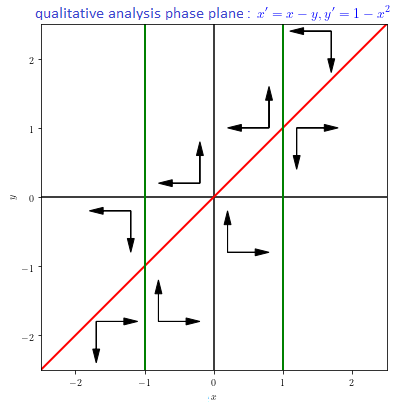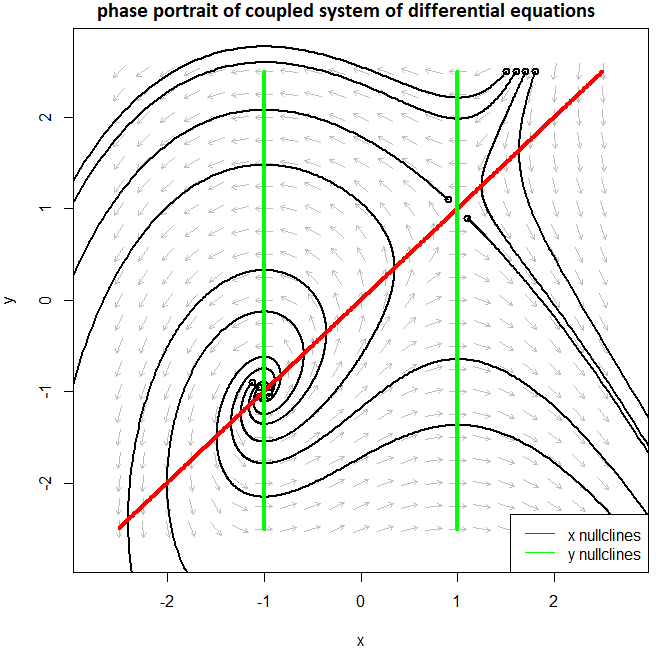Systems of differential equations: Non-linear differential equations
 Second worked-out example
Second worked-out example
We consider the system of differential equations \[\left\{\begin{aligned} \dfrac{\dd x}{\dd t} &=x-y\\[0.25cm] \dfrac{\dd y}{\dd t} &= 1-x^2 \end{aligned}\right.\] Equilibria exist for \(\dfrac{\dd x}{\dd t}=0\) and \(\dfrac{\dd y}{\dd t}=0\), so when \(x-y=0\) and \(1-x^2=0\). Therefore, there are two equilibria: \((1,1)\) and \((-1,-1)\).
The diagram of directions looks like as follows:

We now explore the nature of the equilibria in this system of differential equations. The general form of the Jacobian matrix in \((x,y)\) is \[J(x,y) =\matrix{\dfrac{\partial (x-y)}{\partial x} & \dfrac{\partial (x-y)}{\partial y}\\ \dfrac{\partial (1-x^2)}{\partial x} & \dfrac{\partial (1-x^2)}{\partial y}}=\matrix{1 & -1\\ -2x & 0}\]
- The corresponding linearization in \((1,1)\) is \[\cv{ x'\\ y'}=\matrix{1 & -1\\ -2 & 0}\cv{x\\ y}\] For the computation of the eigenvalues of the Jacobian matrix we need to calculate the zeros of the characteristic polynomial of the matrix. This polynomial is \[\det\matrix{\lambda -1 & 1\\ 2 & \lambda}=(\lambda -1 )\lambda -2=\lambda^2-\lambda-2= (\lambda - 2)(\lambda+1)\] and the zeros are \(\lambda=-1\) and \(\lambda=2\). We have a positive and negative eigenvalue and therefore \((1,1)\) is a saddle point.
- The corresponding linearization in \((-1,-1)\) is \[\cv{ x'\\ y'}=\matrix{1 & -1\\ 2 & 0}\cv{x\\ y}\] For the computation of the eigenvalues of the Jacobian matrix we need to calculate the zeros of the characteristic polynomial of the matrix. This polynomial is \[\det\matrix{\lambda -1 & 1\\ -2 & \lambda}=(\lambda -1 )\lambda +2=\lambda^2-\lambda +2\] and the zeros are \(\lambda=\frac{1\pm\sqrt{1-4\cdot 2}}{2}= \frac{1}{2}\pm\frac{1}{2}\sqrt{7}\ii\). We have complex eigenvalues with a positive real part. Thus, \((-1,-1)\) is an equilibrium with expanding spirals in its neighbourhood as solution curves.
The above analysis is illustrated in the phase portrait below with some solution curves.



